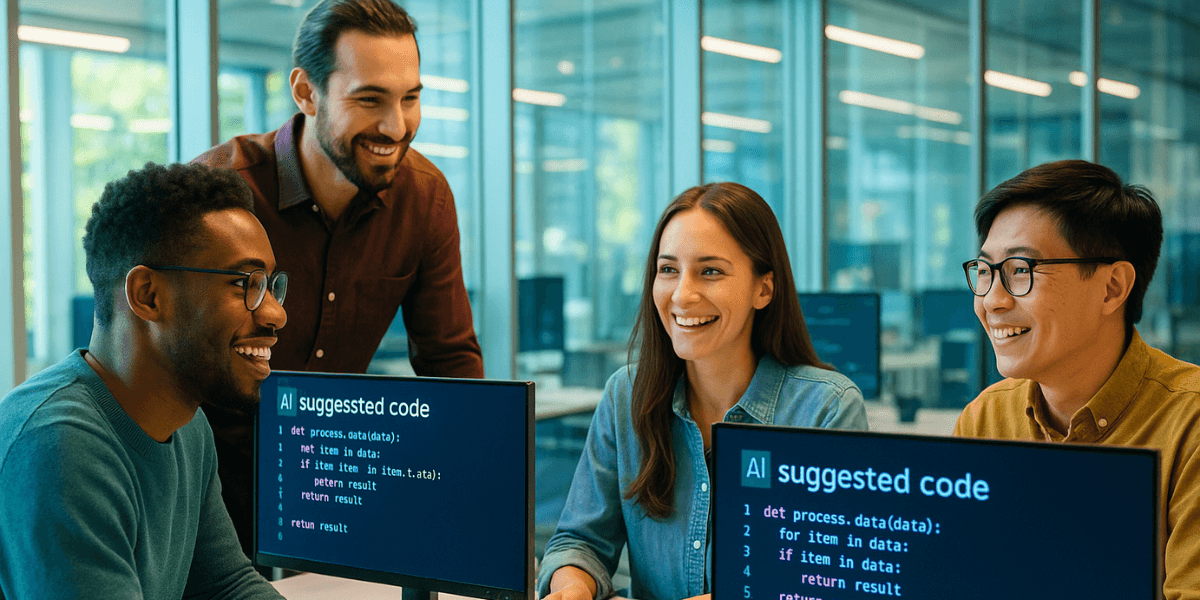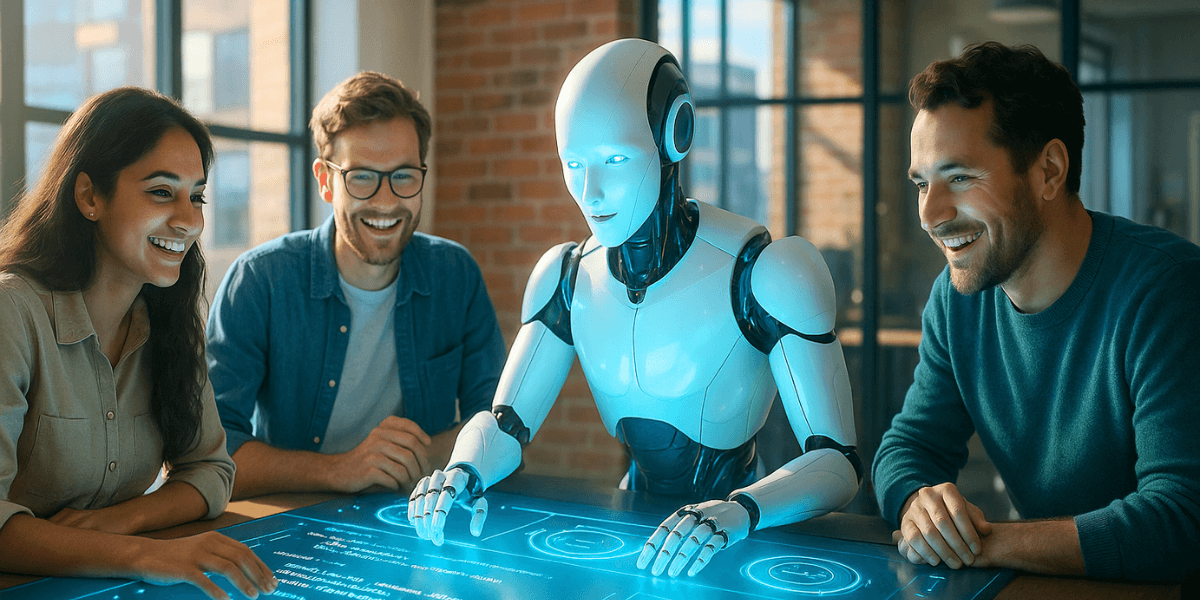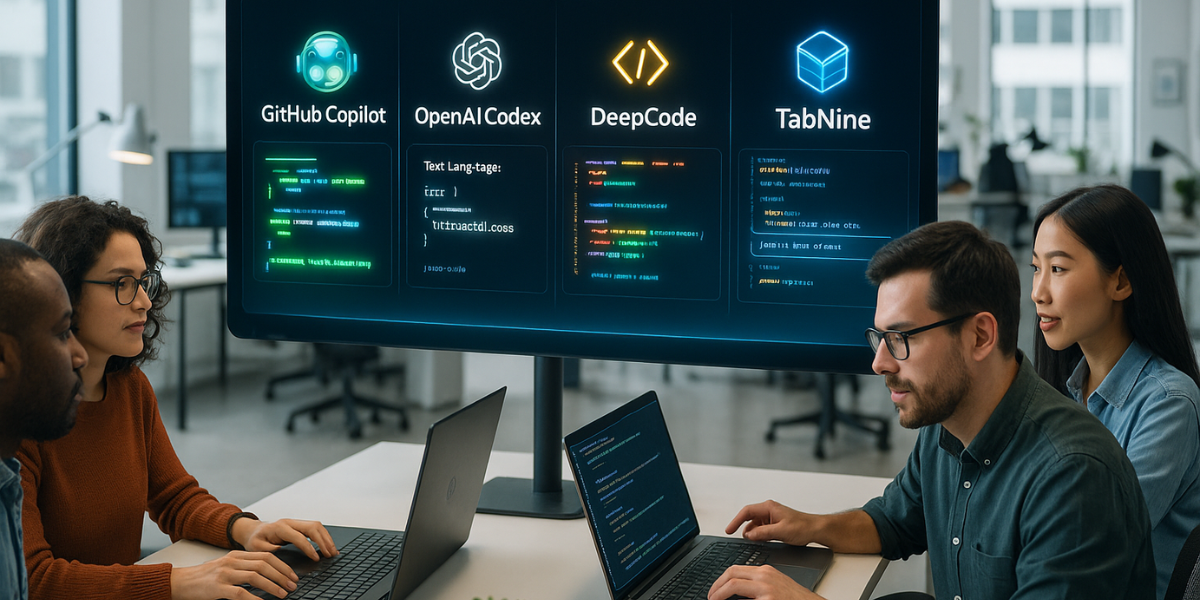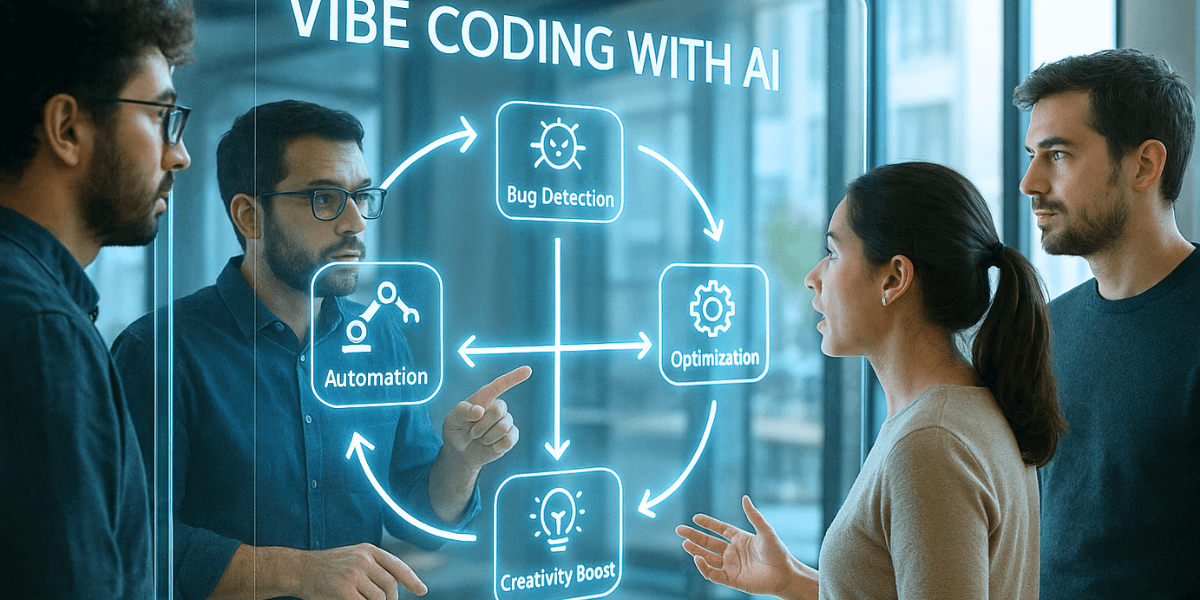Home > Vibe Coding: Will AI Make Developers Disappear?
Artificial intelligence is transforming the world of software development. “Vibe coding” is at the heart of this revolution. But what does it mean for developers? The term “vibe coding” was popularized by Andrej Karpathy in a February 2025 tweet, where he described this style as “a new kind of programming where you fully give in to the vibes, embrace exponentials, and almost forget that the code even exists” (Source: x.com). “Vibe coding” leverages AI to automate coding tasks. It promises to speed up development and reduce errors. However, this technological advance also raises concerns. Developers fear that AI might replace their jobs. Yet, AI could also create new opportunities by freeing developers from repetitive tasks.
AI in coding is not without challenges. Ethical and security questions are crucial. Human–machine collaboration could be the key. Developers must adapt to these changes. Acquiring new skills is essential. AI could transform the developer’s role.

The term “vibe coding” is still relatively new in the field. It refers to a coding process influenced by artificial intelligence. This approach aims to simplify and enrich development.
AI integrates into vibe coding by handling mundane tasks. This includes code suggestions, error correction, and optimization. Developers can therefore focus on more creative aspects.
Despite these advantages, vibe coding is not a magic solution. Its current limitations include dependency on data and system complexity. Developers remain essential to supervise and adjust processes.

Artificial intelligence has deeply transformed software development. It is now ubiquitous across many tools and platforms. This integration has emerged thanks to advances in machine learning.
AI improves several aspects of development. From project management to code quality, its impacts are numerous. Developers take advantage of these innovations to create faster. Among the most notable evolutions are continuous integration and deployment (CI/CD), static code analysis, automatic code generation, the rise of low-code and no-code platforms, as well as the increasing use of automated testing tools.
However, the rise of AI is not without challenges. Security issues and algorithmic bias remain concerning. Developers must stay vigilant in the face of these critical issues.
Despite these challenges, the future looks promising. AI could soon solve even more complex problems. This will require a concerted effort between researchers and practitioners to maximize its potential.

The field of vibe coding has seen the emergence of powerful tools. These platforms automate a large part of the development process.
However, some researchers warn of a potential decline in quality when relying too heavily on these assistants (Source: visualstudiomagazine.com). Meanwhile, a 2024 report ranked GitHub Copilot as the leader among AI coding assistants (Source: visualstudiomagazine.com). Studies such as those by McKinsey also estimate that AI assistants can reduce development time by 20 to 50% (Source: fortegrp.com).
These tools are transforming the traditional role of developers. They act as virtual assistants, boosting efficiency and freeing up time for creativity.

The rise of vibe coding is deeply changing the development landscape. One of the major advantages is the significant time savings. Developers can code more efficiently without compromising quality.
AI also helps to minimize human errors. It analyzes code in depth and detects anomalies before they cause problems. This assistance is particularly valuable for large codebases.
Developers thus benefit from a more dynamic work environment. They can dedicate more time to innovation and solving complex problems.

The rise of AI in development raises many concerns among developers. Some fear that their skills may become obsolete. This fear of automation is legitimate in many industries.
However, the complete disappearance of developers is unlikely. AI mainly plays a role of assistance. It does not replace human creativity or the intuition needed to solve complex problems.
Companies must find a balance between automation and human input. Human–machine collaboration remains essential. It frees developers from repetitive tasks and allows them to spend more time on innovation.

Artificial intelligence has changed the way developers approach creativity. It enables rapid exploration of new ideas and concepts. AI can generate suggestions that fuel human creativity.
In terms of innovation, AI pushes the limits of what is possible. It optimizes brainstorming and prototyping processes. Developers can experiment with solutions that human intuition alone might have overlooked.
Collaboration has also evolved thanks to AI. Teams can use AI-powered tools to improve communication. AI facilitates the management of complex projects and virtual meetings.
These changes bring a new dynamic to software development. The synergy between AI and human teams promises unprecedented innovations.

AI-driven “vibe coding” is not without its limitations. Current AI models still face significant technical challenges. They can generate outputs that are incorrect, biased, or poorly adapted to the context.
An empirical study analyzed 473 GitHub issues, 706 discussions, and 142 Stack Overflow posts. It revealed that many developers encounter inaccurate or hard-to-maintain suggestions with Copilot (Source: sciencedirect.com). Another study highlights that code quality and maintainability remain recurring weaknesses despite productivity gains (Source: researchgate.net).
Moreover, these models require massive volumes of training data, raising concerns related to bias and data balance. Finally, several studies emphasize that AI in coding must always be supervised to minimize the risk of critical bugs (Source: scitepress.org).
The use of AI in vibe coding raises major ethical and legal concerns. Accountability in case of errors remains an open question. If a critical bug is introduced by an AI suggestion, who should bear the responsibility: the developer, the company, or the tool’s publisher? This issue is already being debated by several experts in cybersecurity and digital law (Source: zdnet.com).
Security is another key challenge. Researchers warn that models like Copilot can generate code containing exploitable vulnerabilities if no human supervision is in place (Source: arxiv.org). It is therefore essential to maintain regular audits and ensure human oversight of every generated line.
Intellectual property is also a source of tension. Some organizations argue that AI assistants may reuse snippets of code from public repositories under restrictive licenses. In 2022, a class action lawsuit was even filed against GitHub Copilot for potential copyright infringement (Source: theverge.com).
Finally, the use of massive datasets to train these models raises ethical concerns related to bias and transparency. Reports, particularly from the Gartner Research Board, highlight that trust in AI can only be achieved through clear governance and enhanced explainability (Source: gartner.com).

Artificial intelligence in software development is a divisive topic. For some, it represents a potential threat. However, it also offers many opportunities.
AI may reshape careers rather than destroy them. It frees developers from repetitive tasks and improves efficiency. This allows professionals to focus on creativity and innovation.
The key lies in proactive adaptation. Developers must commit to continuous learning and skill improvement. By embracing AI, they can not only secure their future but also shape the evolution of the industry.
Ultimately, AI should not be seen as a threat but as a powerful ally. With the right approach, it can transform software development into an even more dynamic and stimulating field.

Is vibe coding suitable for programming beginners?
Yes, it can help beginners learn faster by providing code and real-time corrections. But it remains important to understand the fundamentals of development.
Can AI improve collaboration in a development team?
Yes, some AI tools facilitate communication, code sharing, and agile project management. This strengthens collective productivity.
What is the difference between vibe coding and traditional programming?
Traditional programming relies entirely on humans. Vibe coding adds a layer of automated assistance through AI.
Does vibe coding reduce costs for companies?
It can reduce costs related to coding errors and development delays. However, adopting these tools requires an initial investment.
Which industries benefit the most from vibe coding?
Any industry developing software applications can benefit, particularly fintech, healthcare, and manufacturing.
Will vibe coding replace low-code and no-code methods?
No, it complements them. Vibe coding automates traditional coding, while low-code and no-code aim to simplify development without coding.

ITTA is the leader in IT training and project management solutions and services in French-speaking Switzerland.
Our latest posts
Subscribe to the newsletter
Consult our confirmed trainings and sessions

Nous utilisons des cookies afin de vous garantir une expérience de navigation fluide, agréable et entièrement sécurisée sur notre site. Ces cookies nous permettent d’analyser et d’améliorer nos services en continu, afin de mieux répondre à vos attentes.
Monday to Friday
8:30 AM to 6:00 PM
Tel. 058 307 73 00
ITTA
Route des jeunes 35
1227 Carouge, Suisse
Monday to Friday, from 8:30 am to 06:00 pm.